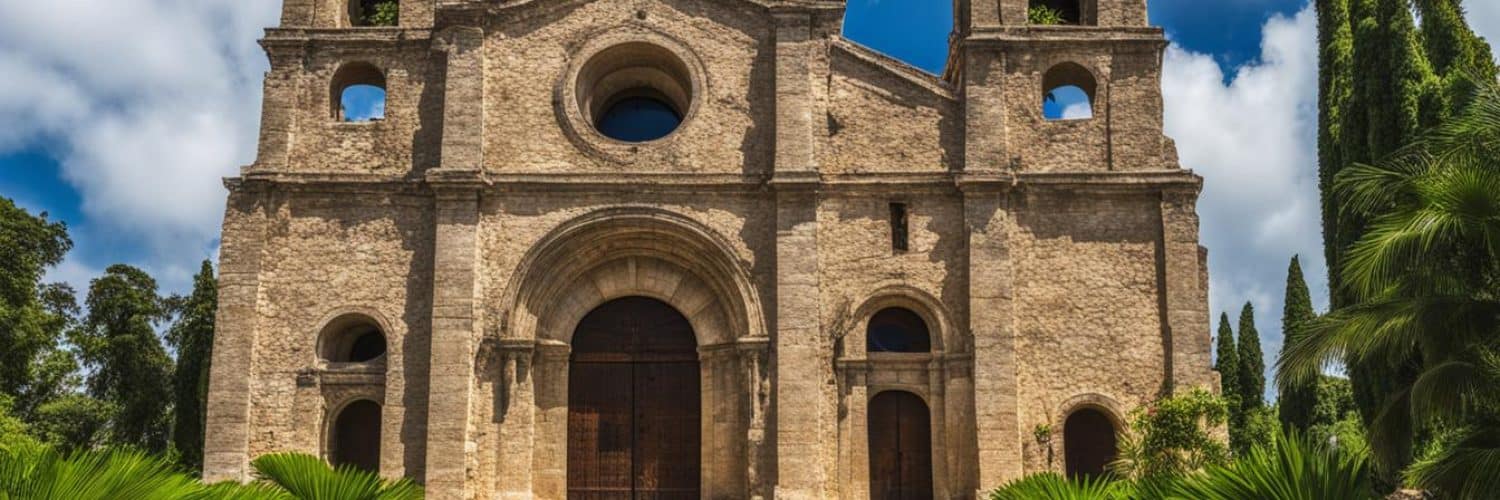The Nuestra Señora de la Luz Parish Church, commonly known as Loay Church, is a Roman Catholic parish church in the municipality of Loay, Bohol, Philippines. It is a historical church, tourist attraction, and religious landmark in the region.
Established by the Jesuits in 1753, the original stone church was built from 1855 to 1864. Loay Church holds deep cultural and historical significance, as it has been declared a National Historical Landmark by the National Historical Commission of the Philippines and a National Cultural Treasure by the National Museum of the Philippines.
Key Takeaways:
- Loay Church is a historic sanctuary and prominent religious landmark in Bohol, Philippines.
- It was established by the Jesuits in 1753 and the original stone church was built from 1855 to 1864.
- The church has been recognized as a National Historical Landmark and a National Cultural Treasure.
- Loay Church showcases Spanish colonial architecture and is renowned for its religious significance.
- The church is a must-visit tourist attraction for those exploring Bohol’s rich history and cultural heritage.
A Brief History of Loay Church
The history of Loay Church dates back to 1753 when it was established by the Jesuits. Originally located in the downtown area known as Napo, the church was later moved to the upper portion of the town called Moto to protect it from pirate raids. Over the years, the church and convent underwent several reconstructions and restorations.
The Jesuits were instrumental in the establishment of the Loay parish, which played a significant role in spreading Roman Catholicism in the region. The church served as a place of worship and spiritual guidance for the local community.
In the 1780s and 1815, the church and convent were rebuilt to improve their structural integrity. However, tragedy struck in the form of devastating fires that broke out in 1850 and 1853, leaving the buildings in ruins.
“The fire was a significant setback for the church, but it did not diminish the faith and determination of the people. They rallied together to rebuild the church, ensuring that its historical and religious significance would be preserved.”
The construction of the current Loay Church commenced in 1855 and was finally completed in 1864. This landmark achievement stands as a testament to the resilience and dedication of the local community.
Over the years, Loay Church has witnessed various changes and restoration efforts to maintain its historic value and architectural beauty. Today, it stands as a Roman Catholic sanctuary and a revered cultural heritage site, recognized as a National Historical Landmark by the National Historical Commission of the Philippines.
Key Events in the History of Loay Church:
- Establishment of Loay Church by the Jesuits in 1753
- Movement of the church from Napo to Moto for protection against pirate raids
- Rebuilding of the church and convent in the 1780s and 1815
- Destruction of the buildings in fires that occurred in 1850 and 1853
- Commencement of the construction of the current Loay Church in 1855
- Completion of the church’s construction in 1864
The image above showcases the magnificence of Loay Church, an architectural masterpiece that has withstood the test of time.
Historical and Cultural Significance
Loay Church holds great historical and cultural significance, making it a cherished site for both locals and visitors. Its importance is officially recognized, as it has been designated as a National Cultural Treasure by the National Museum of the Philippines and a National Historical Landmark by the National Historical Commission of the Philippines.
The recognition of Loay Church as a National Cultural Treasure emphasizes its contribution to preserving the cultural heritage of the country. This historic sanctuary serves as a testament to the rich history and architectural heritage of Bohol, Philippines.
The church’s architecture, with its distinct Spanish colonial design and Baroque elements, showcases the craftsmanship of the past and provides a glimpse into the region’s history. The artworks and religious artifacts found within the church further enhance its cultural value and the story it tells.
“Loay Church is a remarkable testament to the Philippines’ vibrant heritage, and its recognition as a National Cultural Treasure and a National Historical Landmark underscores its importance in preserving our nation’s history for future generations.” – National Historical Commission of the Philippines
Architectural Grandeur and Detailed Craftsmanship
The architecture of Loay Church reflects the grandeur of Spanish colonial influence in the Philippines. Its majestic façade, constructed with coral stones, stands as the sole remaining structure after the devastating fires in the 1850s. The intricate details, inscriptions, statues, and altars within the church exemplify the excellent craftsmanship and devotion that went into its construction.
Religious Significance and Devotion
Loay Church has been a place of worship and devotion for centuries, serving as a significant religious landmark for the community. The church’s patron, the Nuestra Señora de la Luz, is honored within its walls, attracting religious pilgrims from far and wide.
Preserving the Past for Future Generations
By being recognized as a National Cultural Treasure and a National Historical Landmark, Loay Church is protected and preserved for future generations. Efforts to safeguard its structural integrity and maintain its cultural value ensure that the stories and traditions embedded within its walls continue to inspire and educate visitors for years to come.
Explore more about the captivating architecture and rich history of Loay Church in the following table:
| Year | Significance |
|---|---|
| 1753 | The Jesuits established the parish of Loay |
| 1855 – 1864 | The current stone church was constructed |
| 2013 | The church was severely damaged by an earthquake |
| 2021 | The restoration of the church was completed |
Only through the preservation and recognition of historic landmarks like Loay Church can we truly appreciate and understand the cultural heritage that shapes our society.
Earthquake and Restoration
The historic Loay Church and its accompanying convent faced significant damage when a powerful 7.2 magnitude earthquake struck Bohol in 2013. The devastating seismic event reduced the cherished buildings to rubble, leaving the community and visitors devastated.
However, in the face of adversity, a dedicated restoration effort was undertaken to revive the iconic Loay Church. Over the span of eight years, skilled architects, craftsmen, and local community members collaborated tirelessly to restore the church to its former glory.
The restoration process was not without its challenges, but with unwavering commitment and a desire to preserve this important cultural heritage site, the rebuilding efforts were ultimately successful.
As a result of this remarkable restoration work, the National Historic Commission recognized the significance of Loay Church and officially turned over the restored church to the Diocese of Tagbilaran in 2021.
| Year | Event |
|---|---|
| 2013 | 7.2 magnitude earthquake severely damages Loay Church |
| 2014-2021 | Restoration efforts commence and continue |
| 2021 | Official turnover of the restored church to Diocese of Tagbilaran |
Architecture and Design
The Loay Church is renowned for its breathtaking Spanish colonial architecture, reflecting the prominent Baroque style of the era. Its design features a wide rectangular plan, with an internal transept and a crossing surmounted by a quadrangular pyramid, creating an impressive visual impact. The church is constructed using coral stones, adding to its historical authenticity and durability.
Notably, the surviving façade of the Loay Church is a remarkable testament to its rich architectural heritage. It is the only remaining part of the church that survived a devastating fire in the 1850s, making it an invaluable piece of history. The intricate details, inscriptions, statues, and altars within the church intricately showcase the exceptional craftsmanship of the time and offer a glimpse into the aesthetic beauty of Spanish colonial architecture.
Interiors and Artworks
The interiors of Loay Church are a feast for the eyes, showcasing exquisite interior design and a rich collection of artworks. Step inside and be immersed in the beauty and spirituality that defines this revered religious sanctuary.
One cannot help but be captivated by the religious paintings that adorn the walls of the church. These masterpieces, created by talented local artists, depict scenes from biblical stories and saints, bringing the stories of faith to life. The delicate brushstrokes and vibrant colors breathe life into the artworks, evoking a sense of awe and reverence.
“The religious paintings in Loay Church are a testament to the artistic talent and devotion of the local artists.”
The church’s ceilings are adorned with garlands and medallions, meticulously crafted to create a harmonious and visually captivating atmosphere. Each intricate detail tells a story and adds to the overall grandeur of the space, inviting visitors to appreciate the beauty of the church’s interior design.
Altars and Icons
The main altar of Loay Church is the centerpiece of the interior, housing the image of the patroness, Nuestra Señora de la Luz. It serves as a focal point for prayer and devotion, drawing the faithful closer to their faith. The gospel altar and the epistle altar also showcase other religious icons, inviting worshippers to reflect and seek spiritual solace.
As you explore the church, you will encounter other religious artifacts and symbols of faith, including statues and sculptures reflecting the religious heritage of the region. These carefully crafted pieces add depth and meaning to the religious experience within the church.
Whether it’s the intricate paintings, the elaborate garlands, or the presence of religious icons, the interiors of Loay Church offer visitors a window into the region’s rich religious and artistic heritage.
| Highlights of Loay Church Interiors | Description |
|---|---|
| Religious Paintings | A collection of captivating paintings depicting biblical stories and saints, showcasing the artistic talent of local artists. |
| Garlands and Medallions | Elaborate garlands and medallions adorning the ceilings, weaving together art and spirituality. |
| Main Altar | The focal point of the church, housing the image of the patroness, Nuestra Señora de la Luz. |
| Religious Icons | Other altars and icons within the church, representing different saints and aspects of the faith. |
Bell Tower and Other Structures
The Loay Church is not only known for its magnificent architecture and rich history but also for its fascinating structures that enhance the overall beauty of the complex. These structures include the bell tower, the mortuary chapel, and the convent, each with its own unique charm and significance.
The bell tower is a separate structure located just a short distance from the main church building. Its octagonal shape and towering presence add a distinct character to the Loay Church complex. The bell tower, adorned with intricate details, houses six bells that have been an integral part of the church’s history and tradition.
Image:
In front of the church, you’ll find the mortuary chapel, which was built during the 19th century. This chapel served as a place for funeral services and ceremonies, adding a solemn and reverential atmosphere to the church grounds. Its architectural style and design mirror the overall aesthetic of the Loay Church.
At the back of the church stands the convent, which originally served as the dwelling place of the church’s clergy. Today, the convent is repurposed and serves as a school, continuing the tradition of education within the Loay Church community. The convent’s structure adds to the historical significance of the church complex and showcases the adaptability of its architecture over the years.
These additional structures, along with the main church building, contribute to the overall architectural ensemble of the Loay Church. Their presence not only adds visual interest but also enhances the visitor’s experience and understanding of the church’s significance within the community.
Loay Church’s Cultural Significance
Loay Church holds immense cultural and religious importance in the region. As a popular pilgrimage site, it attracts Catholics from all over Bohol who come to seek spiritual solace and partake in religious ceremonies. Additionally, the church serves as a significant tourist attraction for visitors who are fascinated by the rich history and cultural heritage of the area.
The architectural beauty of Loay Church is one of its main highlights. The church’s Spanish colonial design and intricate details showcase the craftsmanship of the past, providing a glimpse into the region’s architectural heritage. Visitors are often captivated by the grandeur of the church’s façade, adorned with statues, carvings, and other ornamental features.
Religious artifacts found within Loay Church also contribute to its cultural significance. The church houses precious relics, religious paintings, and intricate altars that serve as testaments to the strong faith of the churchgoers. These artifacts provide a deeper understanding of the religious practices and traditions upheld within the church.
Furthermore, the historical background of Loay Church adds to its cultural value. With a history dating back to the 18th century, the church has witnessed significant events and has played a pivotal role in the lives of the local community. Exploring the church and learning about its past allows visitors to connect with the cultural heritage of the region.
Overall, Loay Church is a prominent cultural landmark and a must-visit destination for those interested in experiencing the religious and historical aspects of Bohol. Its combination of architectural beauty, religious artifacts, and storied past make it a treasure trove of cultural significance.
Exploring Loay Town
While Loay Church, known as Loay Bohol’s main attraction, draws in many visitors, the town offers a range of other tourist destinations and historical sites waiting to be explored. Wander along the town’s charming streets, soak up the local atmosphere, and discover the unique beauty of Loay.
For nature lovers, nearby beaches provide the perfect escape. Enjoy a leisurely stroll along the shores, take a refreshing dip in the crystal-clear waters, or simply relax and unwind under the warm sun.
If you’re up for an adventure, embark on a cruise along the scenic Loboc River. Marvel at the lush greenery that lines the riverbanks, and immerse yourself in the tranquility of the surroundings. The river cruise offers a unique perspective of Loay’s natural beauty.
History enthusiasts can also explore other historical churches in the area, such as the San Pedro Church, which showcases architectural grandeur and religious significance. These churches provide glimpses into the rich cultural heritage of Loay and its role in shaping the history of Bohol.
Whether you’re interested in history, nature, or simply immersing yourself in the local culture, Loay has something for everyone. Don’t miss the opportunity to discover the hidden gems and experience the allure of this charming town.
Planning Your Visit to Loay Church
When planning a visit to Loay Church in Bohol, Philippines, there are a few travel tips to keep in mind. To make the most of your experience, it’s important to be aware of the admission requirements, opening hours, and transportation options.
Admission and Opening Hours
Loay Church is usually open to the public and does not require an admission fee. However, it is advisable to check the opening hours in advance as they may vary. To fully appreciate the architecture and exquisite interiors, it is recommended to visit during the daytime when natural light enhances the beauty of the church.
Getting There
Loay is conveniently located and easily accessible from Tagbilaran City. You can reach Loay Church by public transportation, such as tricycles or buses. The journey from Tagbilaran City to Loay takes approximately 30 minutes, providing a scenic route through picturesque landscapes and charming towns.
To navigate your way to Loay Church, consider using the following instructions:
- Head to the Tagbilaran City bus terminal.
- Look for buses or tricycles bound for Loay.
- Inform the driver or conductor that you want to visit Loay Church.
- Enjoy the scenic journey to Loay while taking in the stunning views of the countryside.
- Once you arrive in Loay, ask the locals for directions to the church, which is a well-known landmark in the town.
Embark on your journey to Loay Church and immerse yourself in the rich history and cultural heritage it has to offer. Don’t forget to bring your camera to capture the beauty of this historic sanctuary.
| Opening Hours | Admission Fees | Contact Information |
|---|---|---|
| Monday to Saturday: 8:00 AM – 5:00 PM | No admission fee |
Address: Loay, Bohol, Philippines Phone: +63 123 456 789 Email: in**@********ch.com |
Conclusion
Loay Church in Bohol, Philippines, is a historic sanctuary and a cultural heritage site that beautifully exemplifies Spanish colonial architecture and religious significance. With its rich history and stunning architectural features, the church stands as a testament to the cultural heritage of Bohol. The successful restoration of Loay Church following the 2013 earthquake highlights the unwavering commitment to preserving the country’s historical landmarks.
For tourists planning a visit to Bohol, a trip to Loay Church is a must. It offers a unique opportunity to immerse oneself in the region’s rich history and cultural beauty. The church’s intricate designs, religious artifacts, and serene atmosphere provide a captivating experience for visitors of all backgrounds. Whether you are a history enthusiast, a religious pilgrim, or simply a tourist seeking to explore the beauty of Bohol, Loay Church is a destination that should not be missed.
Loay Church’s significance extends beyond its historical and cultural value. It also serves as a major tourist attraction for those exploring Bohol. Its majestic architecture and sacred ambiance make it a favorite spot for photographers, art enthusiasts, and spiritual seekers. The church’s location in the picturesque town of Loay offers additional opportunities to explore other nearby historical sites, charming streets, and beautiful beaches that further enhance the overall travel experience.
When planning your visit to Loay Church, be sure to check the opening hours to make the most of your time there. Loay can be easily accessed from Tagbilaran City by public transportation. Whether you are drawn to the church’s architectural details, religious heritage, or the tranquil ambiance, a visit to Loay Church promises to be a memorable and enriching experience, offering a glimpse into the rich cultural tapestry of Bohol.
FAQ
What is Loay Church?
Loay Church, also known as Nuestra Señora de la Luz Parish Church, is a Roman Catholic parish church located in Loay, Bohol, Philippines. It is a historic sanctuary and a revered cultural heritage site in the region.
When was Loay Church established?
Loay Church was established by the Jesuits in 1753, making it a significant Roman Catholic parish with a long history.
What recognition has Loay Church received?
Loay Church has been declared as a National Historical Landmark by the National Historical Commission of the Philippines and a National Cultural Treasure by the National Museum of the Philippines.
Has Loay Church gone through any restoration process?
Yes, Loay Church was severely damaged by a 7.2 magnitude earthquake in 2013. However, a restoration effort was undertaken, and the church was successfully restored after eight years.
What is the architectural style of Loay Church?
Loay Church features Spanish colonial architecture and exhibits a Baroque style, which adds to its cultural significance and architectural beauty.
What can be found inside Loay Church?
The interiors of Loay Church are adorned with religious paintings, garlands, and medallions. The church houses various artworks, murals, and religious icons, offering a glimpse into the religious and artistic heritage of the region.
Are there any additional structures near Loay Church?
Yes, there is a separate bell tower located at a short distance from the main church building. There is also a mortuary chapel in front of the church, built during the 19th century. The convent at the back of the church is now used as a school.
Why is Loay Church culturally significant?
Loay Church holds significant cultural and religious importance. It is a popular pilgrimage site for Catholics in Bohol and a tourist attraction for visitors interested in the region’s history and heritage.
What other tourist attractions can be found in Loay?
In addition to Loay Church, visitors can explore the charming streets of Loay town, visit nearby beaches, or take a cruise along the scenic Loboc River. Other historical churches, such as the San Pedro Church, can also be found in the area.
What are the travel tips for visiting Loay Church?
When planning a visit to Loay Church, it is advisable to check the opening hours and any admission fees that may apply. The church is usually open to the public, but it is recommended to visit during the daytime to fully appreciate its architecture and interiors. Loay can be easily reached from Tagbilaran City by public transportation.


















Add comment